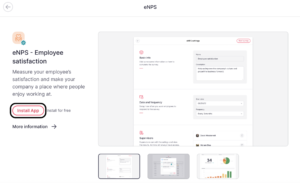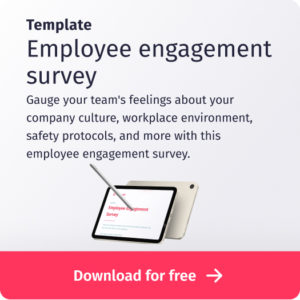The Employee Net Promoter Score (eNPS) is a valuable metric used to calculate the level of employee engagement in your company. It can help you determine how happy your employees are and how committed they are to your organization.
In this guide, we are going to look at how you can calculate eNPS in your business, and what the difference is between eNPS vs NPS. We will also share some tips to help you improve your Employee Net Promoter Score so that you can build a motivated, engaged, and loyal workforce.
TABLE OF CONTENTS
- Why eNPS matters
- What is eNPS?
- eNPS vs NPS
- Track eNPS using HR software
- Benefits of a good eNPS
- Calculating eNPS
- What’s a good eNPS?
- Ways to improve eNPS
- Survey employees with HR software 📊
Why eNPS matters
Why is measuring and tracking your level of employee engagement so important?
According to Gallup, only 32% of U.S. employees are engaged in their jobs. Even more worrying is that the rate of employee engagement has been declining since the start of the pandemic. Employers need to urgently address this growing trend and find ways to engage and motivate their employees. And the first step in doing this is understanding your current level of engagement. And this is precisely what an eNPS does.
What is eNPS?
The Employee Net Promoter Score, more commonly known as eNPS, is a metric used to measure employee engagement and satisfaction. It gives you a quick glimpse into how happy, engaged, and motivated your workforce is. If you measure the metric over time, you can also get valuable insights into the impact of any organizational changes you may have implemented on your workforce. You can then use the feedback you collect to develop strategies to improve your employee experience and boost engagement.
We’ll look at the benefits of tracking this metric in more detail below, but essentially, regularly tracking your eNPS helps you understand how your employees feel about working at your company. You can determine if they are satisfied with their work and your organizational culture, or if there are any issues that you need to address in order to create a better working environment. And this is important because it not only helps you attract and retain talent, but the level of engagement of your team also has a direct impact on productivity.
The process for calculating your eNPS is simple. You just have to share a survey with your employees consisting of one key question: “How likely are you to recommend your workplace to your friends and family on a scale of 0-10?” (With 10 being extremely likely and 0 being not likely at all). Employees who score a 9 or 10 are known as promoters. Those who score a 7 or 8 are passives. And those who score between 0 and 6 are detractors.
We’ll take a look at what these scores and terms mean for your organization shortly.
eNPS vs NPS
So, what’s the difference between eNPS vs NPS?
The Net Promoter Score (NPS), a sales metric developed by Fred Reichheld in 2003, is also used to measure levels of satisfaction and engagement. But instead of being targeted at employees, it’s designed to assess customer satisfaction and loyalty. Many companies use it to determine how likely their customer base would be to recommend their products or services to their friends and family.
When these organizations first realized just how simple and effective the NPS was, many began questioning whether it could be adapted to assess the engagement and satisfaction levels of employees instead of customers. And this adapted metric is what we now refer to as the Employee Net Promoter Score.
Although eNPS and NPS evaluate satisfaction rates from different groups, scores are often correlated. For example, an organization with a high eNPS is far more likely to have a high NPS, too. And this makes sense when you think about it. After all, the happier employees are, the more likely they are to do a good job and transfer this happiness to their customers.
Obtain your eNPS using Factorial's HR software 📊
At Factorial, we understand that gauging employee satisfaction is a huge challenge within human resources. Factorial’s all-in-one HR software offers many tools like time off management, payroll, onboarding and offboarding, and more. One of the newest tools is the eNPS app. Users can easily implement the eNPS app onto their Factorial platform to start gathering necessary data from their teams.

Admins and supervisors can easily change the basic information as well as date and frequency for the eNPS survey before sharing with employees and teams. After collecting the data, eNPS answers can be analyzed under Analytics to further assess how employees feel and what can be improved within your organization.
Benefits of a good eNPS
Before we look at how you can calculate eNPS in your business, let’s take a look at some of the benefits of tracking this important HR metric.
You gain valuable feedback on your culture and working environment
The employee experience has never been so important. Workers are demanding more autonomy, better working environments, and a healthier work-life balance. This means that creating the right culture and working environment is imperative. It helps you attract and retain the talent you need to build a successful organization. Plus, the better your employee experience is, the more engaged your workforce will be. And that’s a big plus because engaged employees show up earlier, work harder, and are more invested in helping their companies achieve organic growth. They are also more likely to stay with their employers.
The best way to identify what your employee experience is like is by asking your employees what they think of you as a company. And this is at the core of what an eNPS survey does. The feedback you collect from your surveys can help you understand if you are creating the right culture and working environment. This is especially true if you include a follow-up question in your survey to find out why employees might be satisfied or dissatisfied.
You can use feedback to improve your employee experience
An eNPS can help you understand how engaged your employees are and what they like or dislike about working for you. But the feedback you collect serves another purpose too – it gives you a baseline to build the strategies you need to improve your employee experience.
For example, if the feedback you collect suggests that there is a lack of employee engagement as a result of your company’s leadership style, then you could offer your managers training to improve their skills in this area. Or if feedback suggests that employees have become demotivated because they haven’t had a salary appraisal for a long time, then you could re-evaluate your payroll structure and budgets to see if there is any wiggle room.
It’s all about understanding what’s having a negative impact on your employee experience, and then implementing reactive strategies to improve every interaction your staff has with your company. That way, you can continuously improve your working environment and, consequently, your Employee Net Promoter Score. Plus, your employees will also feel heard and valued if you address their complaints, further improving your employee experience.
It’s a simple and cost-effective metric
Another big benefit of using the eNPS is how cheap and easy it is to implement.
Unlike most other employee satisfaction surveys which are usually based on multiple questions, an eNPS survey gets straight to the point. Essentially, it asks “Are you happy?”, and “Why/Why not?” (if you choose to include a follow-up question).
What could be simpler than that?
It’s quick and easy for you to create and share, and calculating your results takes no more than a few minutes. It’s also very quick and easy for your employees to complete. And this means that far more employees are likely to participate, so you will get a much more accurate reading from your results than you would with other types of surveys.
It can help you reduce employee turnover
Finally, provided you respond to feedback, an eNPS can help you increase your retention levels. For example, it can help you identify potential causes of high turnover. You can then implement measures to address these causes and retain more staff.
The benefits don’t stop at your turnover rate, either. Responding to the feedback you get from your eNPS survey can also help you reduce employee absenteeism and create a happier, more motivated and more productive workforce.
Calculating eNPS
Now let’s take a look at how you calculate eNPS.
Believe us when we say that this couldn’t be simpler.
So, we already mentioned how the survey consists of one key question: “How likely are you to recommend your workplace to your friends and family on a scale of 0-10?”. So, you will get a single-digit numerical value from each employee that participates in the survey.
You can then categorize each employee according to their score, as follows:
- Promoters: Employees who give the company a score of 9 or 10.
- Passives: Employees who give the company a score of 7 or 8
- Detractors: Employees who give the company a score from 0 to 6.
The next step is calculating your overall eNPS as an organization. Because passives are neutral, you don’t include them in your calculation. Instead, you simply add up your totals for each category, then subtract the percentage of detractors from the percentage of promoters, as follows:
Percentage of promoters (%) – Percentage of detractors (%) = eNPS
This will give you a score between -100 (all employees are detractors) and +100 (all employees are promoters).
For example, let’s say you have 100 employees. 80 of them score as promoters (80%), 5 as passives (5%) and 15 as detractors (15%).
In this case, your eNPS calculation would be:
80 – 15 = eNPS of +65
What’s a good eNPS?
Before we look at eNPS benchmarks, let’s quickly review the categories so that you understand what your results mean:
- Promoters are loyal and engaged employees who are happy working at your company. They are the employees who are most likely to recommend your company to prospective employees and customers.
- Passives are employees who are neither particularly happy nor unhappy. They may be satisfied working for you, but they are probably open to other employment opportunities.
- Detractors are employees who are disengaged and unsatisfied with their jobs. They are most likely to view your organization negatively. This means that they are far less likely to be productive members of staff. It also means that they are much more likely to discourage others from engaging with your company.
Once you’re clear on what each category means, it’s time to review and quantify your results.
As we already mentioned, an eNPS score can range between -100 (all employees are detractors) and +100 (all employees are promoters). Generally speaking, the higher your score (the more promoters you have), the better. However, this can vary by industry and company size so it’s always best to research your industry benchmarks.
Ultimately, though, your best benchmark is your own company. What matters is that you’re making progress. That’s why it’s so important to check your score regularly to see if it is improving.
How to improve eNPS
Let’s finish by looking at a few strategies and best practices you can use to improve your eNPS.
Include a follow-up question
Strictly speaking, the eNPS survey is based on just one question: “How likely are you to recommend your workplace to your friends and family on a scale of 0-10?”
However, you can also use the survey as an opportunity to collect qualitative data from participants. You can do this by including an open-ended follow-up question inviting them to explain the reasons for their score. This will help you understand why an employee is happy or unhappy. And these answers will give you the constructive feedback you need to create strategies to address identified issues.
Remember to keep it simple though. The question should be brief and open-ended. It should serve as a platform for employees to explain why they have given the score that they gave. If you have any other questions then save them for more comprehensive employee feedback surveys.
Use feedback to create strategies to improve employee engagement
Perhaps the most valuable tip we can give is to make sure you use your feedback to create strategies to improve employee engagement. Without these strategies, your eNPS is unlikely to improve over time.
For example, if your feedback suggests that employees are unhappy with the lack of diversity and inclusion in your organization, then you could create a DEIB policy and implement a series of DEI initiatives to promote diversity. Or if employees complain about a lack of career progression, you could implement a learning and development program to help them learn new skills.
It’s all about identifying areas for improvement and listening to what your employees need. Once you’ve done that, act on their feedback and do what you can to provide them with the culture and working environment they need to become engaged, motivated, and productive members of your team.
Remind employees that your eNPS survey is anonymous
When you share your eNPS survey, remind your employees that their feedback is anonymous. This will reassure them that they can be open and honest with their answers without fear of recrimination. And that will help you get a much more authentic perspective on how happy your workforce is.
This is also a good opportunity to remind your employees that you are actively listening to them and that you care about what they have to say. This will help your employees feel valued and heard. It will also show them that you are committed to continuously improving their working environment.
Keep an open mind
When you collect your results and calculate your score, make sure you keep an open mind. Don’t take any feedback personally. Remember, negative and constructive feedback is an opportunity for you to improve. Don’t get defensive if you don’t see the results you’d hoped for.
Measure your eNPS regularly
Finally, the ultimate aim of calculating your eNPS is to improve your employee experience. It’s therefore important that you regularly measure your score to see how you are progressing. That way, you can see what sort of an impact any new strategies or organizational changes are having on the overall engagement and satisfaction levels of your workforce.
Remember, a stand-alone score is meaningless. Make it count by checking in regularly with your employees to see what they think about your business. Ideally, you want to see your score improve over time. If it doesn’t, then you need to re-evaluate your strategies to work out where you’re going wrong. That way, you will fully benefit from everything that the eNPS has to offer.






